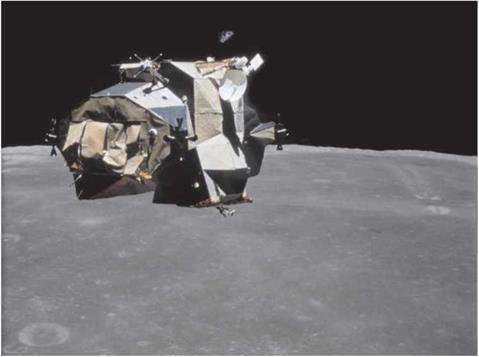Mascons: a lumpy Moon
Over a one-year period between 1966 and 1967. five Lunar Orbiicr spacecraft were dispatched to the Moon to carry out comprehensive photo-reconnaissance of its surface largely in support of the Apollo programme. It was mostly through this programme that engineers gained the skills necessary to accurately track an object around the Moon and control its flight path. As they did so. they were surprised to discover that, unlike orbits around Hanh where the gravity field is nearly uniform, the orbits of these spacecraft were being perturbed by regions of higher density in the Moon’s crust that often seemed to be associated with the circular maria. It appeared that events in the Moon’s past had bequeathed it with a gravity field which, to scientists of the late L960s. seemed unexpectedly uneven. Subsequent analysis suggested that the majority of these mass concentrations, or ‘mascons’ as they came to be known, are due to denser mantle material having been brought nearer the surface by the impacts that formed the basins, and, to a lesser extent, by the layers of dense basalt that were extruded onto the surface to fill these basins and form the maria. This ability to determine a body’s sub-structure by analysis of a spacecraft’s flight path would be built upon over succeeding decades as spacecraft were sent to orbit around other bodies in the solar system. It became a powerful technique that would reveal much about their large-scale structures.
Mascons complicated the mission planning process for Apollo because of their profound effects on lunar orbits. Since they are largely on the near side, they accelerate spacecraft slightly when compared to the far side. Over a remarkably short time, and with some help from perturbations due to Earth’s gravity, lunar orbits are modified by being lowered on the near side and raised on the far side until, if no intervention occurs, they cause the spacecraft to impact the lunar surface. As later high – precision gravity maps of the Moon would reveal. Apollos 15 and 17 happened to fly over two of the most intense mascons – those associated with Marc Sercniiatis and Mare Imbrium.
On Apollo 1 5, FIDO compensated for the effects of the mascons by targeting the pcrilunc of the descent orbit a little high in the expectation that while the crew slept, it would drop to about L5 kilometres, the preferred altitude from wilich the LM should begin its descent to the surface. This strategy had worked well on Apollo 14, which flew around the lunar equator, but because the intensity of the Imbrium and Serenitatis mascons had not been appreciated, the perilune of the Apollo 15 orbit descended below 15 kilometres while the crew were asleep. The monitoring flight controllers reckoned that by the time Scott and Irwin were ready to begin their final descent, their perilune would be down to around 10 kilometres, which was much lower than had been trained for. However, with their usual foresight, the planners had inserted a possible adjustment to the orbit into the flight plan in case this happened, and CMP A1 Worden made a small trim manoeuvre to raise the perilune. On Apollo 16. no trim was required. Its equatorial flight path took it away from the strongest mascons and lessened the gradual drop of its perilune which, in any case. FIDO had targeted even higher for the DOI manoeuvre.
For Apollo 17. the lessons from Apollo 15 were applied, and the DOI manoeuvre was split into two parts to deal with the influence of the Imbrium and Screnitaiis mascons. As with the previous flights, the CSM America burned an initial DOI manoeuvre. This took their perilune down to a safe 26.5 kilometres which, overnight, dropped to 22 kilometres. After the separation of the LM Challenger, the two spacecraft went behind the Moon for the last lime before landing. While out of sight of Earth. America returned to its 110-kilometre circular orbit, and Challenger burned the second DOI manoeuvre that dropped its perilune right down to 13 kilometres. Since they only had half an orbit to go before their final descent to the surface, there would not be enough time for mascons to perturb their trajectory.
Constantly learning from their operational experience, flight controllers and planners had become pretty savvy by the end of the Apollo programme. These were important lessons that would be applied to space operations as a whole across succeeding generations of space exploration.











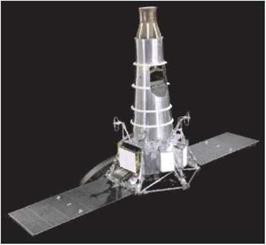 However, it was the American unmanned missions that gained prominence in acquiring high-grade knowledge of the Moon prior to the Apollo programme. In the process, NASA learned how to design reliable spacecraft for the lunar environment and how to operate them from a distance. For a manned landing to be attempted, as Kennedy had directed in 1961, it was essential that the engineers designing the lunar module be aware of the nature of its surface. The best Earth-based images at the time showed features no smaller than about a kilometre across, and were hardly suitable for finding rocks and slopes that could topple a lander.
However, it was the American unmanned missions that gained prominence in acquiring high-grade knowledge of the Moon prior to the Apollo programme. In the process, NASA learned how to design reliable spacecraft for the lunar environment and how to operate them from a distance. For a manned landing to be attempted, as Kennedy had directed in 1961, it was essential that the engineers designing the lunar module be aware of the nature of its surface. The best Earth-based images at the time showed features no smaller than about a kilometre across, and were hardly suitable for finding rocks and slopes that could topple a lander.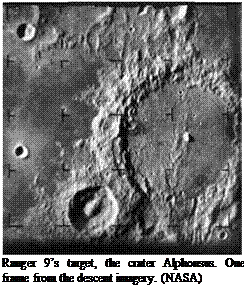 The final probe in the series, Ranger 9, was given over to the scientists who programmed it to dive into Alphonsus, a large, distinctive crater near the centre of the Moon’s disk. They were particularly interested in a number of unusual dark patches within the crater which appeared to be the result of volcanism. This mission was also of interest to commercial TV networks, which broadcast the spectacular live images streaming back from the spacecraft so that the public could watch its suicidal dive in real time. The final frames from these probes showed surface features as small as half a metre across and, to the relief of the lunar module designers, the presence of large rocks sitting on the soil strongly suggested that the surface would be able to support a LM.
The final probe in the series, Ranger 9, was given over to the scientists who programmed it to dive into Alphonsus, a large, distinctive crater near the centre of the Moon’s disk. They were particularly interested in a number of unusual dark patches within the crater which appeared to be the result of volcanism. This mission was also of interest to commercial TV networks, which broadcast the spectacular live images streaming back from the spacecraft so that the public could watch its suicidal dive in real time. The final frames from these probes showed surface features as small as half a metre across and, to the relief of the lunar module designers, the presence of large rocks sitting on the soil strongly suggested that the surface would be able to support a LM.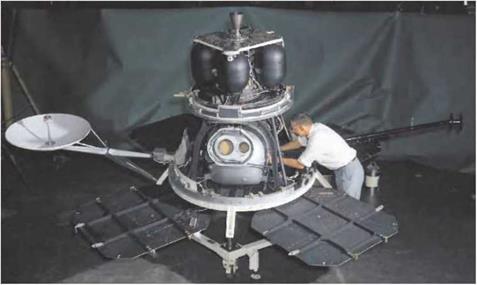

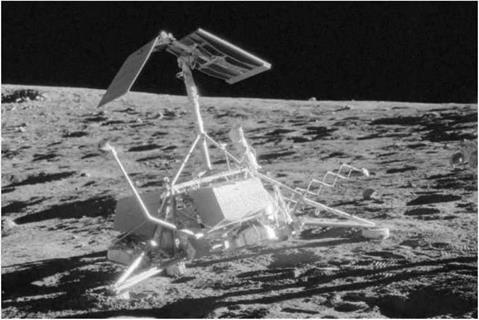
 Once the spacecraft had begun its long coast back to Earth, the CMP made a brief spacewalk down the side of the service module to retrieve the cassettes for both the panoramic and the mapping cameras.
Once the spacecraft had begun its long coast back to Earth, the CMP made a brief spacewalk down the side of the service module to retrieve the cassettes for both the panoramic and the mapping cameras.